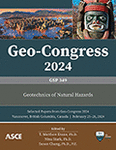Fractile-Based Mean Spectral Matching with Dispersion Control
Publication: Geo-Congress 2024
ABSTRACT
Performing nonlinear response history analyses for structural design and site ground motion response analyses requires selecting a suite of representative input ground motions as input to the analyses. Each selected ground motion can be amplitude-scaled such that the mean response spectrum (or resultant spectrum) of the entire suite matches approximately to a target spectrum. Spectral matching, such as tight spectral matching and mean spectral matching, can also be used to further adjust the selected suite of ground motions to produce a closer match of the suite mean to the target spectrum. This study proposes a new approach to mean spectral matching practice that defines the target variation (dispersion) within the ground motion suite to the probabilistic seismic hazard analysis framework. By using a fractile analysis, the dispersion of ground motions can be quantified to produce a more realistic variability that is consistent with the variability from the probabilistic seismic hazard analysis. A case study and scaling algorithm is presented. Two spectral matching tools, namely RSPMatch and REQPY, are used to modify the seed ground motions, and the results show the proposed method can be a potential expansion to the mean spectral matching method.
Get full access to this article
View all available purchase options and get full access to this chapter.
REFERENCES
Abrahamson, N. A., and Bommer, J. J. 2005. Probability and Uncertainty in Seismic Hazard Analysis. Earthquake Spectra. 2005;21(2):603–607.
ASCE 7-16. American Society of Civil Engineers. Minimum Design Loads for Buildings and Other Structures. American Society of Civil Engineers, 2016.
Hancock, J., Watson-Lamprey, J., Abrahamson, N., Bommer, J., Markatis, A., McCoy, E., and Mendis, R., 2006. “An improved method of matching response spectra of recorded earthquake ground motion using wavelets,” Journal of Earthquake Engineering, Vol. 10, Special Issue 1, pp. 67–89.
International Code Council. 2017. 2018 International Building Code.
Mazzoni, S., Hachem, M., and Sinclair, M., 2012, September. An improved approach for ground motion suite selection and modification for use in response history analysis. In XV World Conference on Earthquake Engineering. Lisbon.
Montejo, L. A. (2021). Response spectral matching of horizontal ground motion components to an orientation-independent spectrum (RotDnn). Earthquake Spectra, 37(2), 1127–1144.
NIST. (2011). GCR 11-917-15: Selecting and scaling earthquake ground motions for performing response-history analyses. National Institute of Standards and Technology, US Department of Commerce: Gaithersburg, MD, USA.
Shahi, S. K. and Baker, J. W. (2014). “An efficient algorithm to identify strong velocity pulses in multi-component ground motions.” Bulletin of the Seismological Society of America, 104(5), 2456–2466.
Information & Authors
Information
Published In
History
Published online: Feb 22, 2024
ASCE Technical Topics:
- Case studies
- Earthquake engineering
- Engineering fundamentals
- Geohazards
- Geomechanics
- Geotechnical engineering
- Geotechnical investigation
- Ground motion
- Mathematics
- Methodology (by type)
- Probability
- Research methods (by type)
- Seismic effects
- Seismic tests
- Soil dynamics
- Soil mechanics
- Structural control
- Structural engineering
- Structural health monitoring
- Tests (by type)
Authors
Metrics & Citations
Metrics
Citations
Download citation
If you have the appropriate software installed, you can download article citation data to the citation manager of your choice. Simply select your manager software from the list below and click Download.
